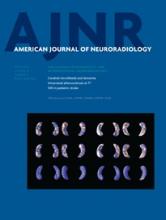Research ArticleBrain
Open Access
Bayesian Estimation of Cerebral Perfusion Using Reduced-Contrast-Dose Dynamic Susceptibility Contrast Perfusion at 3T
K. Nael, B. Mossadeghi, T. Boutelier, W. Kubal, E.A. Krupinski, J. Dagher and J.P. Villablanca
American Journal of Neuroradiology April 2015, 36 (4) 710-718; DOI: https://doi.org/10.3174/ajnr.A4184
K. Nael
aFrom the Department of Medical Imaging (K.N., B.M., W.K., E.A.K., J.D.), University of Arizona, Tucson, Arizona
B. Mossadeghi
aFrom the Department of Medical Imaging (K.N., B.M., W.K., E.A.K., J.D.), University of Arizona, Tucson, Arizona
T. Boutelier
bOlea Medical SAS (T.B.), La Ciotat, France
W. Kubal
aFrom the Department of Medical Imaging (K.N., B.M., W.K., E.A.K., J.D.), University of Arizona, Tucson, Arizona
E.A. Krupinski
aFrom the Department of Medical Imaging (K.N., B.M., W.K., E.A.K., J.D.), University of Arizona, Tucson, Arizona
J. Dagher
aFrom the Department of Medical Imaging (K.N., B.M., W.K., E.A.K., J.D.), University of Arizona, Tucson, Arizona
J.P. Villablanca
cDepartment of Radiological Sciences (J.P.V.), University of California, Los Angeles, Los Angeles, California.

REFERENCES
- 1.↵
- Lansberg MG,
- Straka M,
- Kemp S, et al
- 2.↵
- Albers GW,
- Thijs VN,
- Wechsler L, et al
- 3.↵
- Davis SM,
- Donnan GA,
- Parsons MW, et al
- 4.↵
- Hu LS,
- Baxter LC,
- Pinnaduwage DS, et al
- 5.↵
- Law M,
- Yang S,
- Babb JS, et al
- 6.↵
- 7.↵
- Ryu CW,
- Lee DH,
- Kim HS, et al
- 8.↵
- Nael K,
- Meshksar A,
- Ellingson B, et al
- 9.↵
- Armitage PA,
- Schwindack C,
- Bastin ME, et al
- 10.↵
- Weber MA,
- Zoubaa S,
- Schlieter M, et al
- 11.↵
- Kanal E,
- Barkovich AJ,
- Bell C, et al
- 12.↵
- 13.↵
- 14.↵
- Manka C,
- Traber F,
- Gieseke J, et al
- 15.↵
- Alger JR,
- Schaewe TJ,
- Liebeskind DS, et al
- 16.↵
- Østergaard L,
- Weisskoff RM,
- Chesler DA, et al
- 17.↵
- 18.↵
- 19.↵
- Wu O,
- Østergaard L,
- Weisskoff RM, et al
- 20.↵
- 21.↵
- 22.↵
- 23.↵
- 24.↵
- 25.↵
- Mouridsen K,
- Friston K,
- Hjort N, et al
- 26.↵
- Leenders KL,
- Perani D,
- Lammertsma AA, et al
In this issue
American Journal of Neuroradiology
Vol. 36, Issue 4
1 Apr 2015
Advertisement
K. Nael, B. Mossadeghi, T. Boutelier, W. Kubal, E.A. Krupinski, J. Dagher, J.P. Villablanca
Bayesian Estimation of Cerebral Perfusion Using Reduced-Contrast-Dose Dynamic Susceptibility Contrast Perfusion at 3T
American Journal of Neuroradiology Apr 2015, 36 (4) 710-718; DOI: 10.3174/ajnr.A4184
0 Responses
Jump to section
Related Articles
- No related articles found.
Cited By...
- Assessment of a Bayesian Vitrea CT Perfusion Analysis to Predict Final Infarct and Penumbra Volumes in Patients with Acute Ischemic Stroke: A Comparison with RAPID
- Bayesian Estimation of CBF Measured by DSC-MRI in Patients with Moyamoya Disease: Comparison with 15O-Gas PET and Singular Value Decomposition
This article has not yet been cited by articles in journals that are participating in Crossref Cited-by Linking.
More in this TOC Section
Similar Articles
Advertisement











